
Aptos vs Sui in 2025: Detailed Comparison
In 2025, the so-called “Move Wars” are heating up. Two rising stars—Aptos and Sui—have emerged as the leading contenders built on the Move programming language, both offering high throughput, low latency, and a fresh model for smart contract development.
But their strategies have sharply diverged.
Aptos is gaining traction through real-world use cases, such as powering the digital wallet for Expo 2025 and preparing major upgrades to its protocol. Meanwhile, Sui is accelerating on-chain activity, thanks to ultra-fast consensus improvements, growing DeFi traction, and a spot ETF application in the U.S.—a bold step few altchains have taken.
Though they share common origins in Facebook’s Diem project, their tech stack, adoption paths, and community priorities are now moving in different directions.
This article compares Aptos vs Sui across these key areas: technology, performance, adoption, tokenomics, and outlook for 2025.
Key Takeaways
Aptos: Utilizes the original Move programming language and a Byzantine Fault Tolerant (BFT) consensus mechanism to achieve high throughput and low latency, making it suitable for a broad spectrum of decentralized applications (dApps).
Sui: Employs a modified version of the wMove language and a Directed Acyclic Graph (DAG) structure, coupled with the Narwhal and Tusk consensus mechanism, focusing on scalability and rapid transaction finality, particularly for high-frequency applications.
Common Ground: Both Aptos and Sui are emerging Layer 1 blockchains that leverage the Move programming language, originally developed for Meta's Diem project. They aim to enhance scalability and performance in the blockchain space, with Aptos targeting a wide range of dApps and Sui tailored for applications requiring swift transaction processing, such as gaming and real-time services.
Key differences between Aptos and Sui
Aptos | Sui | |
Key features | Programming Language: Utilizes the original Move language developed for Meta's Diem project. | Programming Language: Uses a modified version of the Move language with an object-centric model. |
Transaction speed & Fees | Transaction Speed: Aptos has achieved a peak performance of 13,367 transactions per second (TPS) without failures, delays, or spikes in gas fees. | Transaction Speed: Sui has demonstrated the capability to process up to 297,000 transactions per second (TPS) under optimal conditions. |
Long-Term Potential | Use Cases: Targets a broad spectrum of decentralized applications (dApps), including DeFi and NFTs. | Use Cases: Focuses on applications requiring rapid transaction finality, such as gaming and real-time services. |
Supply | Total Supply: 1.128 billion APT tokens. | Total Supply: 10 billion SUI tokens. |
Consensus algorithm | Byzantine Fault Tolerant (BFT) consensus. | Narwhal and Tusk, separating data availability from consensus. |
Performance over the past 1 year | -42.8% | +216.1% |
Security | BFT consensus ensures resilience against malicious actors. | Narwhal and Tusk provide fault tolerance and security. |
Earning | The current annual percentage yield (APY) for staking APT is approximately 7.25%. | The current APY for staking SUI is approximately 2.8%. |
Adoption and Community Support | Ecosystem: Active development with multiple projects and partnerships enhancing its ecosystem. | Ecosystem: Growing interest from developers focusing on high-performance applications. |
Aptos vs. Sui: Transaction Speed & Fees
Transaction Speed:
Aptos: Aptos utilizes a Byzantine Fault Tolerant (BFT) consensus mechanism, facilitating high throughput and low latency. On its mainnet, Aptos has achieved a peak performance of 13,367 transactions per second (TPS) without failures, delays, or spikes in gas fees.
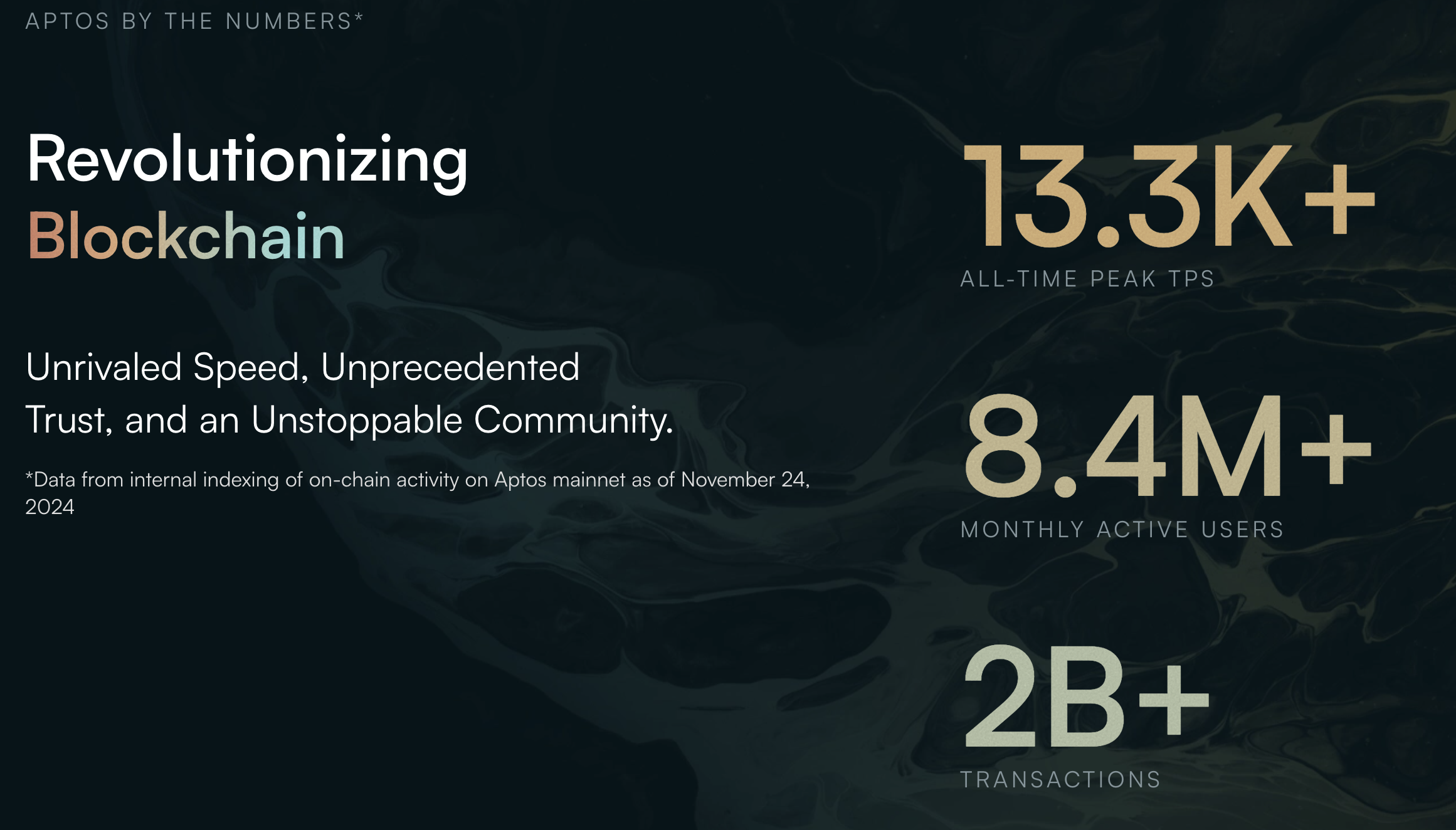
Sui: In controlled testing environments, Sui has demonstrated the capability to process up to 297,000 transactions per second (TPS) under optimal conditions. In early 2025, Sui rolled out “Mysticeti v2", cutting consensus latency further (following a prior ~80% reduction).
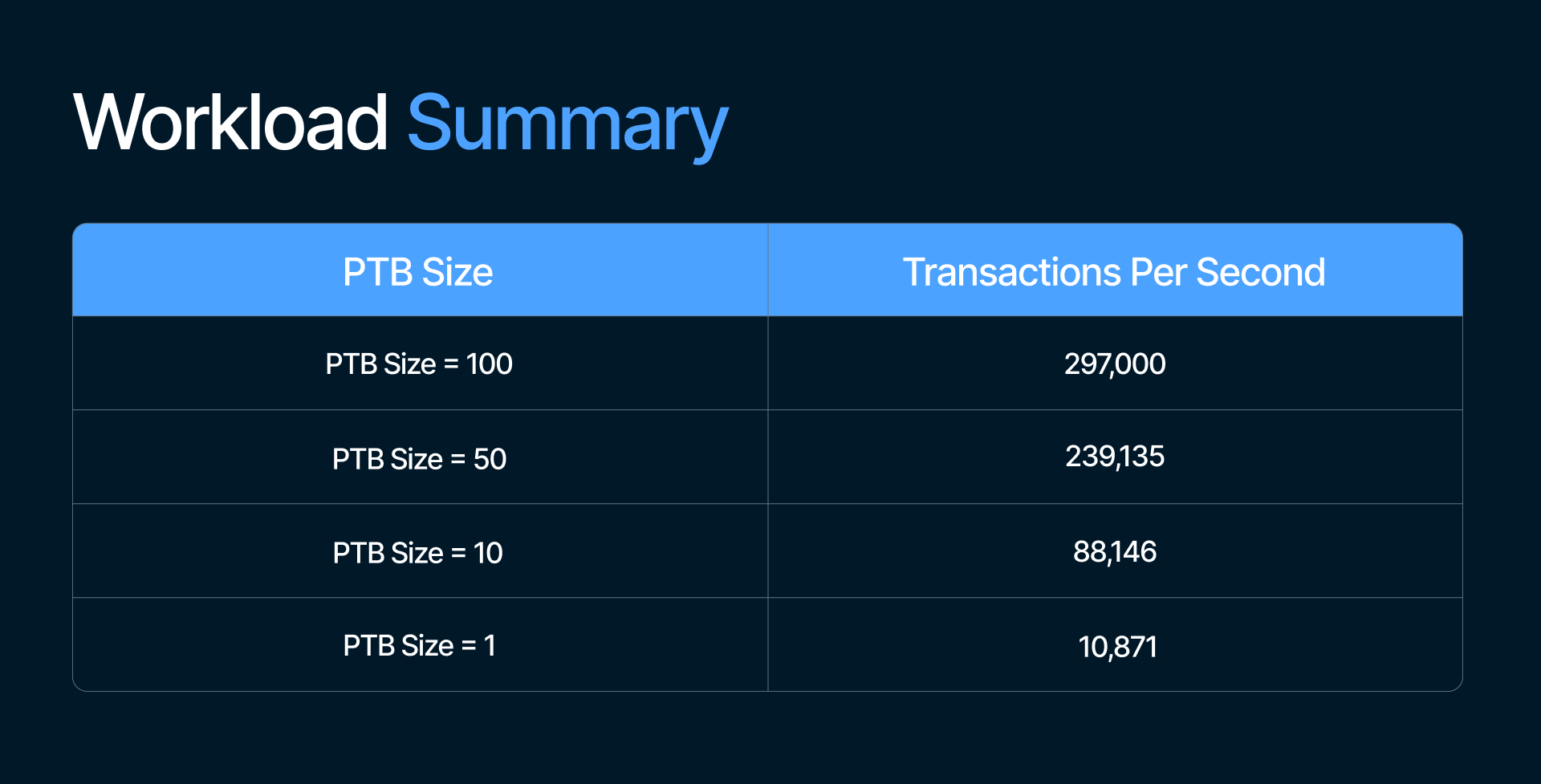
However, real-world performance on the mainnet can differ due to various factors such as network load and user activity. According to data from Suiscan, over the past 12 months, Sui's peak TPS is 822 TPS.
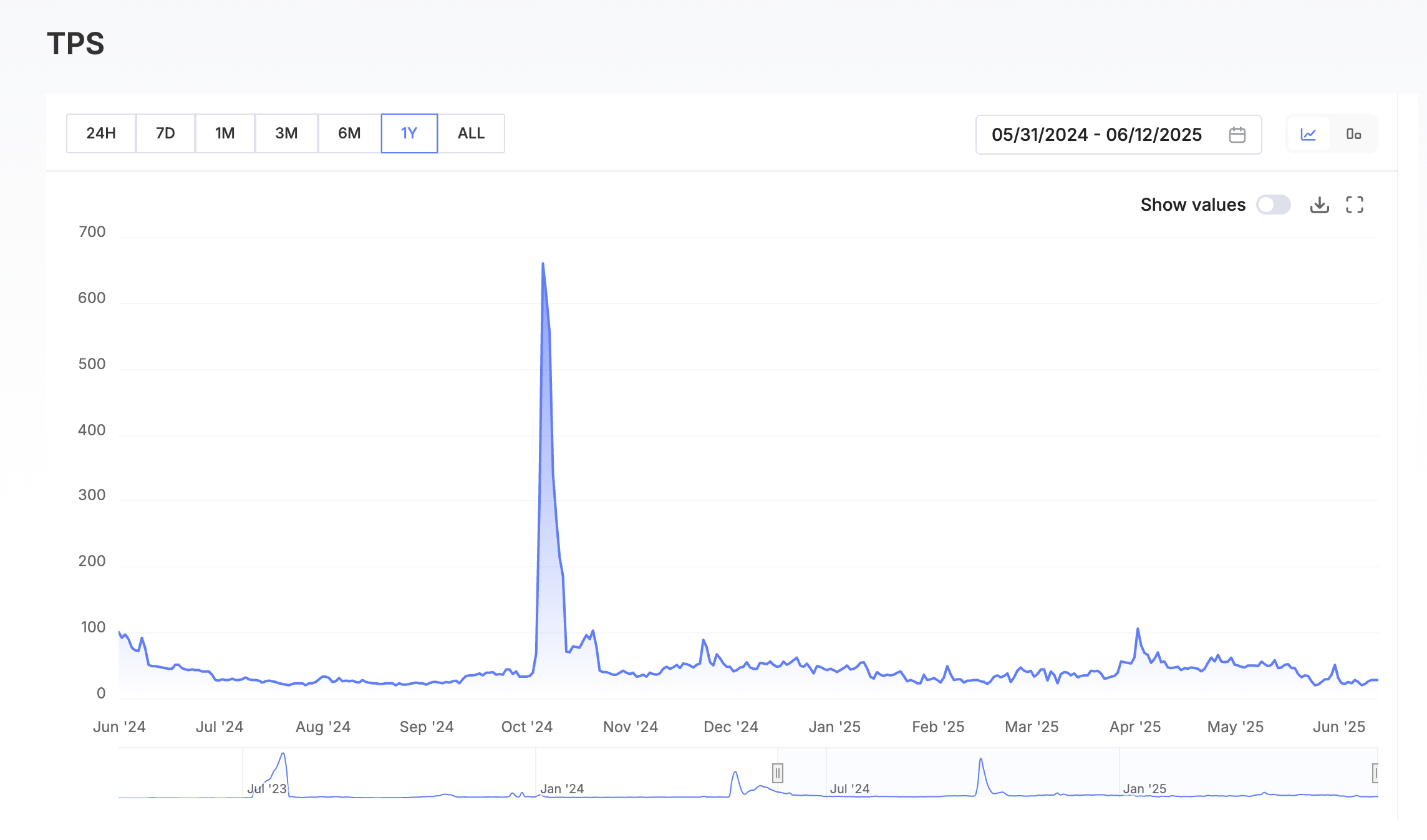
Transaction Fees:
Aptos: According to Aptoscan, over the past year, the average transaction fee on the Aptos blockchain has been approximately 0.0002 APT (~0.002USD).
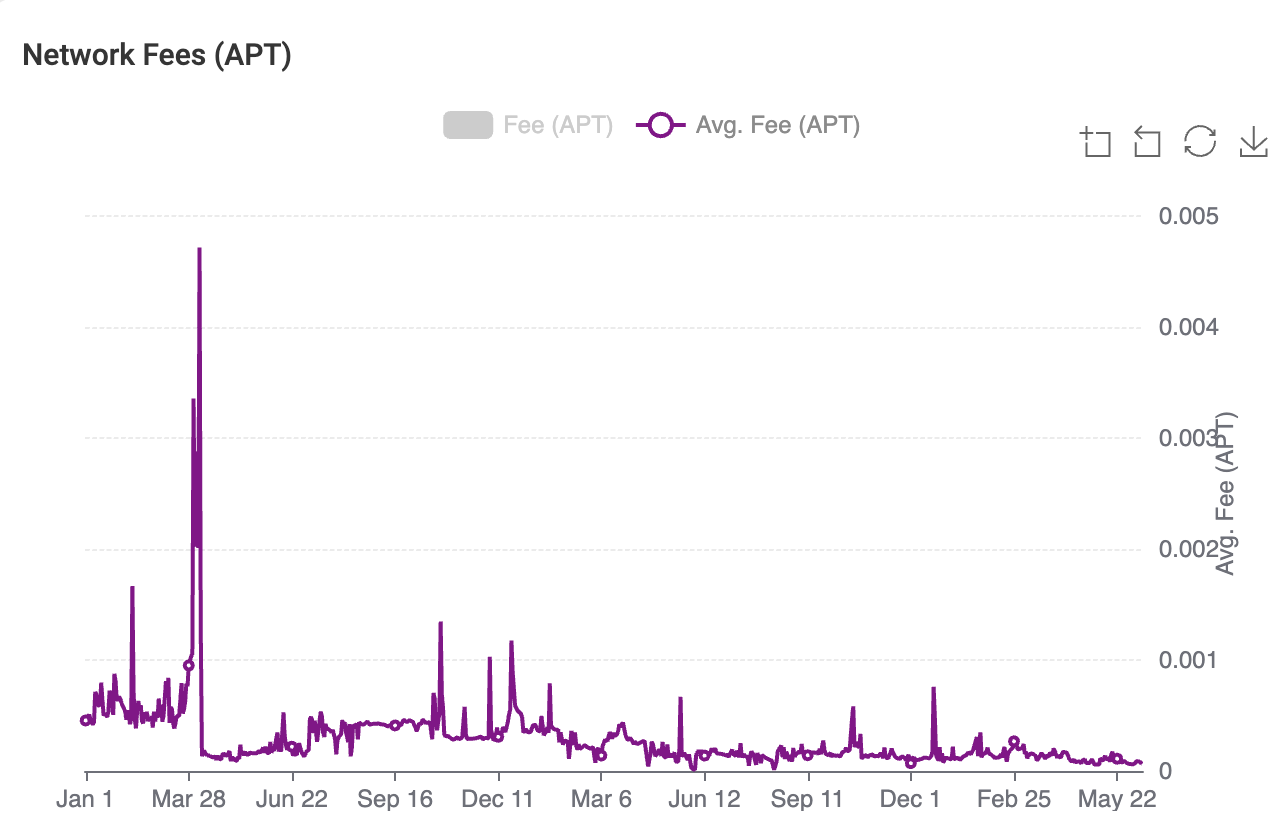
Sui: According to Suiscan, over the past year, the average transaction fee on the Sui blockchain has been approximately 0.0037 Sui (~0.01USD).
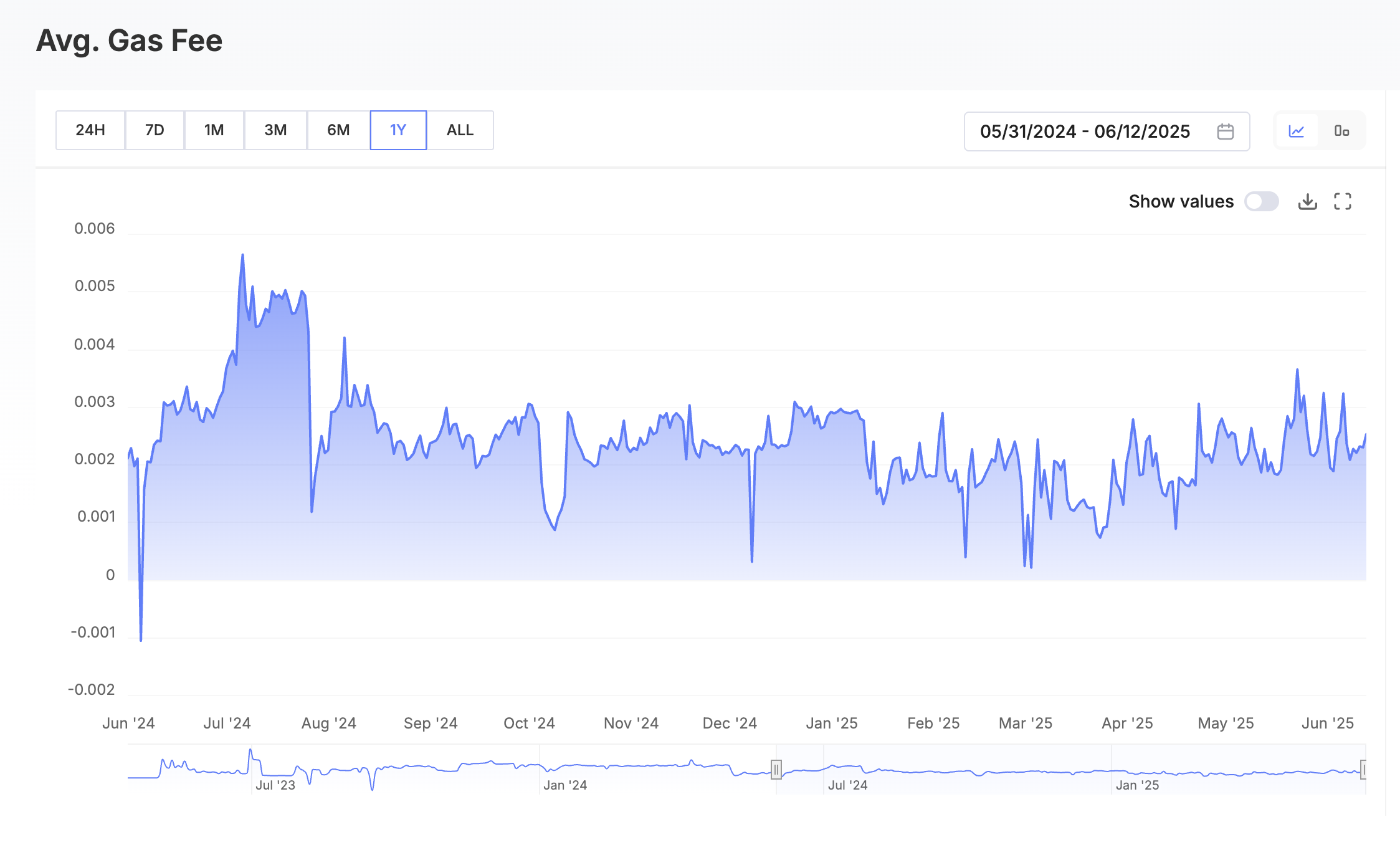
Comparison Summary:
Transaction Speed: While Sui has demonstrated higher potential TPS in testing environments, Aptos has achieved more consistent and higher transaction speeds on its mainnet.
Transaction Fees: Both platforms offer low transaction fees, with Aptos providing a slightly more cost-effective solution.
Aptos vs. Sui: Long-Term Potential
When evaluating the long-term prospects of Aptos and Sui, it's crucial to consider their technological foundations, recent developments, and market positioning.
1. Technological Foundations
Aptos:
Consensus Mechanism: Aptos employs a Byzantine Fault Tolerant (BFT) consensus protocol, ensuring high throughput and low latency. This design supports a wide range of decentralized applications (dApps) with minimal transaction finality times.
Programming Language: Utilizes the original Move programming language, developed for Meta's Diem project, facilitating secure and efficient smart contract development.
Architecture: Features a modular design that allows for seamless upgrades and scalability, accommodating future technological advancements.
Sui:
Consensus Mechanism: Adopts the Narwhal and Tusk consensus protocol, which separates data availability from consensus, enabling efficient transaction processing and high scalability.
Programming Language: Employs a modified version of the Move language with an object-centric model, enhancing flexibility in smart contract development.
Architecture: Utilizes a Directed Acyclic Graph (DAG) structure for data storage, allowing parallel transaction processing and reducing latency.
2. Recent Developments
Aptos:
Ecosystem Expansion: Active development with multiple projects and partnerships enhancing its ecosystem, including collaborations with various decentralized finance (DeFi) platforms and non-fungible token (NFT) marketplaces.
Performance Enhancements: Continuous upgrades to improve transaction throughput and reduce latency, positioning Aptos as a competitive platform for high-performance dApps.
Sui:
Developer Engagement: Growing interest from developers focusing on high-performance applications, particularly in gaming and real-time services, leveraging Sui's rapid transaction finality.
Community Initiatives: Active community engagement through hackathons and developer grants to foster innovation within the Sui ecosystem.
3. Market Position and Adoption
Aptos:
Target Audience: Aims to attract a broad spectrum of dApp developers by offering a scalable and secure platform suitable for various applications, including DeFi, NFTs, and enterprise solutions.
Adoption Strategy: Focuses on building a robust developer community and forming strategic partnerships to drive ecosystem growth and real-world use cases.
Sui:
Target Audience: Concentrates on applications requiring rapid transaction finality, such as gaming and real-time services, leveraging its high throughput capabilities.
Adoption Strategy: Emphasizes performance and scalability to attract developers building high-frequency applications, aiming to establish a niche in the blockchain space.
4. Conclusion:
Both Aptos and Sui present promising long-term potential, each with distinct technological innovations and strategic focuses. Aptos offers a versatile platform suitable for a wide range of applications, while Sui targets high-performance use cases requiring rapid transaction processing. Their success will depend on continued technological advancements, ecosystem development, and the ability to attract and retain a vibrant developer community.
Difference between Aptos and Sui in Supply
Aptos (APT):
Total Supply: 1.128 billion APT tokens.
Circulating Supply: Approximately 534 million APT tokens are currently in circulation, representing about 47.3% of the total supply.
Inflation Rate: Initially, the annual inflation rate was set at 7%. This rate decreases by 1.5% each year until it stabilizes at 3.5%.(expected to take over 50 years).
Staking Yield: According to AptoStake,the recent staking APY of Aptos is about 7.25%
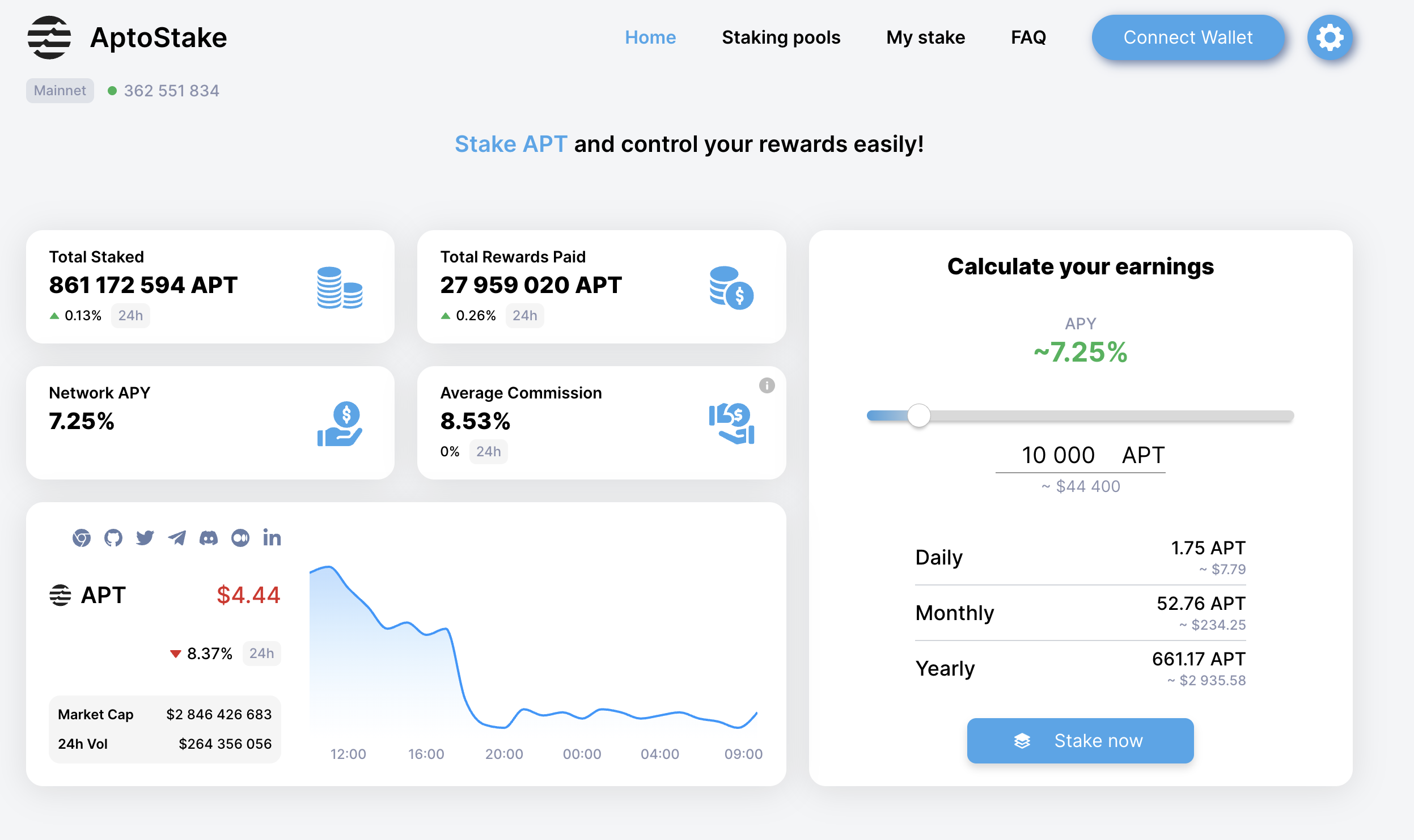
Sui(SUI):
Total Supply: 10 billion SUI tokens.
Circulating Supply: Approximately 2.85 billion SUI tokens are currently in circulation, accounting for about 28.5% of the total supply.
Inflation Rate: Sui has a capped total supply, and there is no indication of an inflationary mechanism.
Staking Yield: According to StakingRewards,the recent staking APY of Sui is about 2.8%
Supply Comparison Table:
Aptos (APT) | Sui (SUI) | |
Total Supply | 1.128 billion APT | 10 billion SUI |
Circulating Supply | ~534 million APT (47.3% of total) | ~2.85 billion SUI (28.5% of total) |
Inflation Rate | The annual inflation rate was set at 7%. This rate decreases by 1.5% each year until it stabilizes at 3.5% | Fixed supply, no inflation |
Staking Yield | 7.25% | 2.80% |
Aptos vs Sui: Consensus Algorithm
Aptos: AptosBFT Consensus Mechanism
1. Byzantine Fault Tolerance (BFT): Aptos employs a variant of the Proof of Stake (PoS) consensus mechanism known as AptosBFT, which is an evolution of the HotStuff protocol. This ensures that the network can reach consensus even if some nodes act maliciously or fail, maintaining security and reliability. 2. Leader Rotation and Reputation System: Aptos introduces an innovative reputation system that automatically adjusts leader rotations based on validator performance. This automation allows Aptos to validate transactions in under a second, enhancing efficiency without human intervention. 3. Parallel Execution with Block-STM: Utilizing Block-STM, Aptos enables parallel execution of transactions by dynamically identifying dependencies and allocating tasks accordingly. This approach allows the network to process up to 160,000 transactions per second (TPS), significantly boosting scalability.
Sui: Narwhal and Tusk Consensus Mechanism
1. Asynchronous Byzantine Fault Tolerance (aBFT): Sui employs an asynchronous BFT consensus protocol comprising two components: Narwhal and Tusk. Narwhal ensures data availability, while Tusk handles transaction ordering. This separation allows for efficient and secure consensus, even in asynchronous network conditions. 2. Causal Ordering for Simple Transactions: For transactions that do not involve shared objects, Sui bypasses traditional consensus by using causal ordering. This method allows for parallel execution of independent transactions, reducing latency and increasing throughput. 3. Parallel Transaction Processing: Sui's architecture is designed to process multiple transactions simultaneously, leveraging its Directed Acyclic Graph (DAG) structure. This design enables Sui to achieve high throughput, with theoretical capabilities of processing up to 297,000 TPS.
Comparison Summary:
Consensus Approach: Aptos utilizes a PoS-based AptosBFT protocol with leader rotation and a reputation system, focusing on rapid finality and validator performance. In contrast, Sui employs an asynchronous BFT protocol (Narwhal and Tusk) and leverages causal ordering for simple transactions, emphasizing parallel processing and scalability.
Transaction Throughput: Aptos achieves up to 160,000 TPS through its Block-STM parallel execution engine. Sui, with its DAG-based architecture, boasts a higher theoretical throughput of up to 297,000 TPS.
Finality and Latency: Both platforms aim for low-latency transaction finality. Aptos achieves sub-second finality, while Sui's design allows for rapid finality, particularly for simple transactions that do not require full consensus.
Aptos vs Sui: Performance over the Past 1 Years
Metric | Aptos(APT) | Sui(SUI) |
1-Year Return | -42.8% | +216.1% |
2025 YTD Return | -49.2% | -21.8% |
Over the past 12 months, Sui has outpaced Aptos in growth—tripling its total value locked (TVL), while Aptos has only doubled, despite launching earlier.
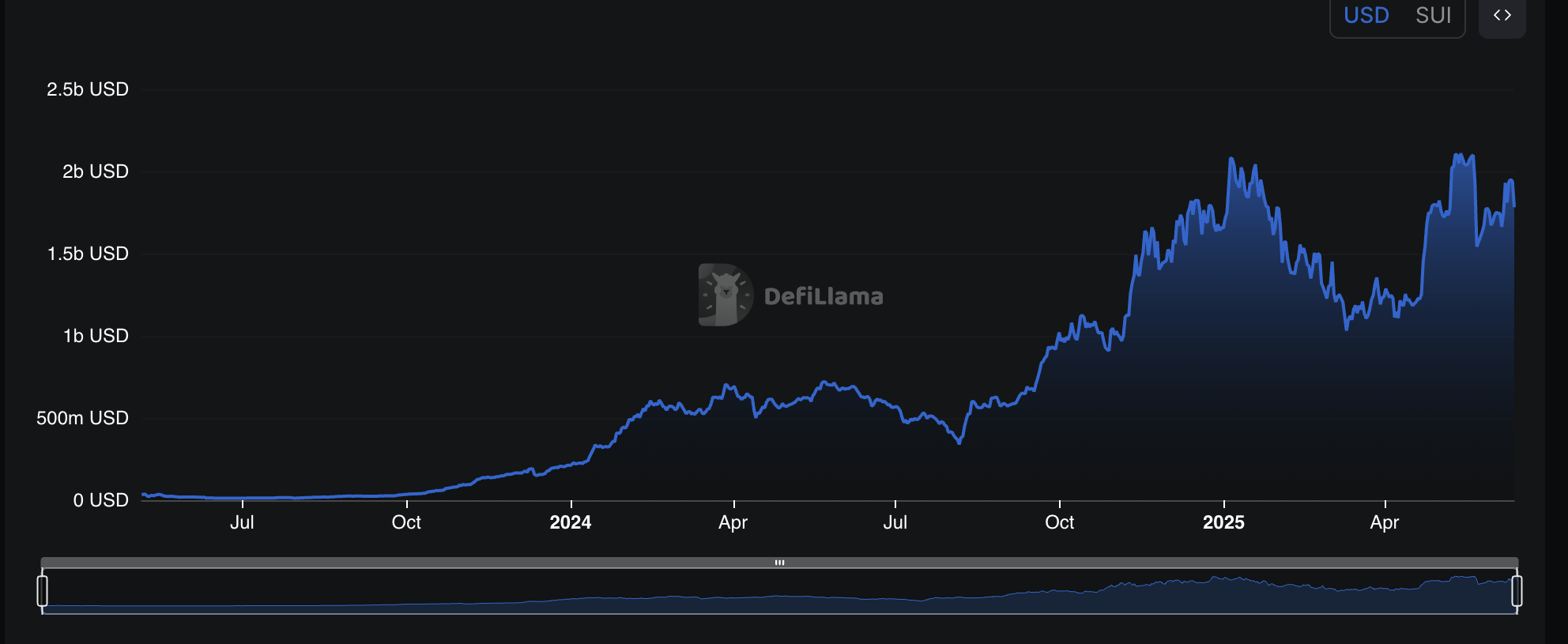
Difference between Aptos and Sui in Security
Aptos:
Consensus Mechanism: Aptos employs a Byzantine Fault Tolerant (BFT) consensus protocol, which enhances security by allowing the network to function correctly even if some nodes act maliciously or fail. This design ensures that the system can tolerate a certain number of faulty nodes without compromising the integrity of the blockchain.
Security Features: The BFT consensus in Aptos provides resilience against various attack vectors, maintaining network stability and data integrity. By requiring a majority agreement among nodes, it prevents malicious actors from easily altering transaction histories or causing disruptions.
Sui:
Consensus Mechanism: Sui introduces an object-centric model, differing from traditional account-based models. This approach allows for parallel transaction processing, which can enhance throughput and efficiency. However, specific details about Sui's consensus algorithm and its security implications are less documented in the available sources.
Security Features: While Sui's object-centric model offers potential performance benefits, the security aspects of this design are not extensively covered in the provided information. Further research into Sui's official documentation would be necessary to fully understand its security model.
Comparison:
Both Aptos and Sui aim to provide secure and efficient blockchain platforms, each with unique approaches to consensus and transaction processing. Aptos leverages a BFT consensus to ensure fault tolerance and security, while Sui's object-centric model focuses on parallel transaction execution. The choice between the two may depend on specific use cases and the importance of certain features such as transaction speed, scalability, and the maturity of the security model.
On May 22, an exploit on the Cetus DEX drained $223 M in assets—but $162 M was swiftly recovered after Sui validators intervened by freezing the attacker’s addresses. While this move raised concerns about decentralization, it also demonstrated the network’s ability to respond decisively to unethical activity and protect users in critical moments. Sui’s validator coordination may not reflect a fully permissionless structure yet, but it shows a clear commitment to security and user protection during high-stakes incidents
Aptos vs. Sui: Earning Opportunities
Aptos (APT):
Staking: Aptos operates on a Delegated Proof-of-Stake (DPoS) consensus mechanism, allowing APT holders to delegate their tokens to validators. By doing so, participants contribute to network security and earn staking rewards. The current annual percentage yield (APY) for staking APT is approximately 7.25%.
Delegated Staking: Aptos introduced delegated staking to enhance accessibility. This feature enables users to delegate their staking power to trusted validators without running a validator node themselves, thereby earning rewards while maintaining control over their tokens.
Transaction Fees: Transaction fees on the Aptos network are currently burned, meaning they are removed from circulation. This approach may be revisited in the future through on-chain governance voting.
Sui (SUI):
Staking: Sui utilizes a Delegated Proof-of-Stake (DPoS) system, allowing SUI token holders to delegate their tokens to validators. In return, they earn staking rewards. The current APY for staking SUI is approximately 2.8%.
Validator Selection: When staking on Sui, choosing a reliable validator is crucial, as factors like commission rates and validator performance can impact the rewards received. Stakers should periodically review their chosen validator's performance to optimize earnings.
Transaction Fees: Transaction fees collected on the Sui network are distributed to delegators in proportion to their stake. This means that active participation in staking not only secures the network but also provides a share of the transaction fees as rewards.
Comparison:
Staking Rewards: Aptos offers a higher staking APY (∼7.25%) compared to Sui's ∼2.8%.
Delegated Staking: Both networks support delegated staking, enabling token holders to earn rewards without operating validator nodes.
Transaction Fees: On Aptos, transaction fees are currently burned, whereas on Sui, they are distributed to stakers, providing an additional earning avenue.
In summary, both Aptos and Sui provide earning opportunities through staking, with Aptos offering a higher APY. However, Sui's model includes the distribution of transaction fees to stakers, potentially enhancing overall rewards.
Aptos vs. Sui: Adoption and Community Support
Adoption Overview
Aptos: Aptos is a Layer 1 blockchain platform that emphasizes scalability, safety, and user experience. Since its mainnet launch in 2022, Aptos has seen significant growth, with numerous projects and decentralized applications (dApps) being developed within its ecosystem. The platform's focus on developer-friendly tools and resources has attracted a vibrant community of builders and users. In 2025, Aptos was also powering the official digital wallet for Expo 2025 in Osaka, processing 558,000+ transactions and onboarding 133,000+ users.
Sui: Sui is another Layer 1 blockchain that aims to deliver high-performance and secure decentralized applications. The Sui Foundation is dedicated to advancing the global adoption of the Sui blockchain, with initiatives to onboard the next billion users to web3. Sui's unique object-centric model and Move programming language have garnered interest from developers seeking innovative solutions. Riding the momentum of cryptocurrency spot ETFs, Sui has also submitted an application to the SEC this year—signaling growing interest from institutional investors.
Community Support
Aptos: The Aptos community is active and growing, with various programs to engage and support its members. The Aptos Collective, the official ambassador program, brings together passionate contributors to collaborate on ecosystem projects and participate in exclusive initiatives. Additionally, the Aptos Foundation provides grants and resources to developers and projects that contribute to the network's growth.
Sui: The Sui community is also robust, with the Sui Foundation playing a pivotal role in fostering engagement. The foundation offers grants to developers, educators, researchers, and community members driving the adoption and advancement of Sui. Community events and programs provide opportunities for networking and collaboration among Sui builders.
Real-World Usage
Aptos: Aptos supports a wide range of applications, including decentralized finance (DeFi), non-fungible tokens (NFTs), and gaming. Its high throughput and low latency make it suitable for applications requiring fast and efficient transaction processing. The platform's developer-friendly environment has led to the creation of various tools and services that enhance user experience.
Sui: Sui's architecture is designed to support high-performance dApps, with a focus on delivering the benefits of web3 with the ease of web2. The platform's unique data model and consensus mechanism enable efficient transaction processing, making it suitable for applications that demand high scalability and security.
Conclusion
Both Aptos and Sui are making significant strides in the blockchain space, each with unique approaches to adoption and community engagement. Aptos's emphasis on scalability and developer support has cultivated a dynamic ecosystem of dApps and services. Meanwhile, Sui's focus on delivering web3 benefits with web2 ease positions it as a compelling platform for high-performance applications. The choice between the two depends on specific use cases and the desired features for developers and users.
Aptos vs. Sui: Which One Is Better?
Aptos and Sui are emerging Layer 1 blockchain platforms, each offering unique features and targeting different aspects of the blockchain ecosystem.
Aptos:
Scalability and Performance: Aptos utilizes a Byzantine Fault Tolerant (BFT) consensus mechanism, enabling high throughput and low latency. This design supports a wide range of applications, including decentralized finance (DeFi), non-fungible tokens (NFTs), and gaming.
Developer-Friendly Environment: Aptos emphasizes a developer-centric approach, providing robust tools and resources to facilitate the creation of decentralized applications (dApps). This focus has attracted a growing community of developers and projects to its ecosystem.
Sui:
Innovative Data Model: Sui introduces an object-centric data model, allowing for parallel transaction processing. This architecture enhances scalability and performance, making it suitable for applications requiring high throughput.
Focus on Web3 Adoption: Sui aims to deliver the benefits of Web3 with the ease of Web2, striving to onboard the next billion users to decentralized applications. The Sui Foundation supports developers and projects through grants and resources, fostering a vibrant ecosystem.
Conclusion:
Both Aptos and Sui offer compelling features tailored to different use cases. Aptos's emphasis on scalability and a developer-friendly environment makes it an attractive choice for building diverse dApps. In contrast, Sui's innovative data model and focus on seamless Web3 adoption position it as a strong contender for applications requiring high performance and user-friendly experiences. The choice between Aptos and Sui depends on specific project requirements and goals. Developers and businesses should consider factors such as scalability needs, development tools, community support, and the target user base when selecting a platform.

Aptos vs Sui in 2025: Detailed Comparison
In 2025, the so-called “Move Wars” are heating up. Two rising stars—Aptos and Sui—have emerged as the leading contenders built on the Move programming language, both offering high throughput, low latency, and a fresh model for smart contract development.
But their strategies have sharply diverged.
Aptos is gaining traction through real-world use cases, such as powering the digital wallet for Expo 2025 and preparing major upgrades to its protocol. Meanwhile, Sui is accelerating on-chain activity, thanks to ultra-fast consensus improvements, growing DeFi traction, and a spot ETF application in the U.S.—a bold step few altchains have taken.
Though they share common origins in Facebook’s Diem project, their tech stack, adoption paths, and community priorities are now moving in different directions.
This article compares Aptos vs Sui across these key areas: technology, performance, adoption, tokenomics, and outlook for 2025.
Key Takeaways
Aptos: Utilizes the original Move programming language and a Byzantine Fault Tolerant (BFT) consensus mechanism to achieve high throughput and low latency, making it suitable for a broad spectrum of decentralized applications (dApps).
Sui: Employs a modified version of the wMove language and a Directed Acyclic Graph (DAG) structure, coupled with the Narwhal and Tusk consensus mechanism, focusing on scalability and rapid transaction finality, particularly for high-frequency applications.
Common Ground: Both Aptos and Sui are emerging Layer 1 blockchains that leverage the Move programming language, originally developed for Meta's Diem project. They aim to enhance scalability and performance in the blockchain space, with Aptos targeting a wide range of dApps and Sui tailored for applications requiring swift transaction processing, such as gaming and real-time services.
Key differences between Aptos and Sui
Aptos | Sui | |
Key features | Programming Language: Utilizes the original Move language developed for Meta's Diem project. | Programming Language: Uses a modified version of the Move language with an object-centric model. |
Transaction speed & Fees | Transaction Speed: Aptos has achieved a peak performance of 13,367 transactions per second (TPS) without failures, delays, or spikes in gas fees. | Transaction Speed: Sui has demonstrated the capability to process up to 297,000 transactions per second (TPS) under optimal conditions. |
Long-Term Potential | Use Cases: Targets a broad spectrum of decentralized applications (dApps), including DeFi and NFTs. | Use Cases: Focuses on applications requiring rapid transaction finality, such as gaming and real-time services. |
Supply | Total Supply: 1.128 billion APT tokens. | Total Supply: 10 billion SUI tokens. |
Consensus algorithm | Byzantine Fault Tolerant (BFT) consensus. | Narwhal and Tusk, separating data availability from consensus. |
Performance over the past 1 year | -42.8% | +216.1% |
Security | BFT consensus ensures resilience against malicious actors. | Narwhal and Tusk provide fault tolerance and security. |
Earning | The current annual percentage yield (APY) for staking APT is approximately 7.25%. | The current APY for staking SUI is approximately 2.8%. |
Adoption and Community Support | Ecosystem: Active development with multiple projects and partnerships enhancing its ecosystem. | Ecosystem: Growing interest from developers focusing on high-performance applications. |
Aptos vs. Sui: Transaction Speed & Fees
Transaction Speed:
Aptos: Aptos utilizes a Byzantine Fault Tolerant (BFT) consensus mechanism, facilitating high throughput and low latency. On its mainnet, Aptos has achieved a peak performance of 13,367 transactions per second (TPS) without failures, delays, or spikes in gas fees.
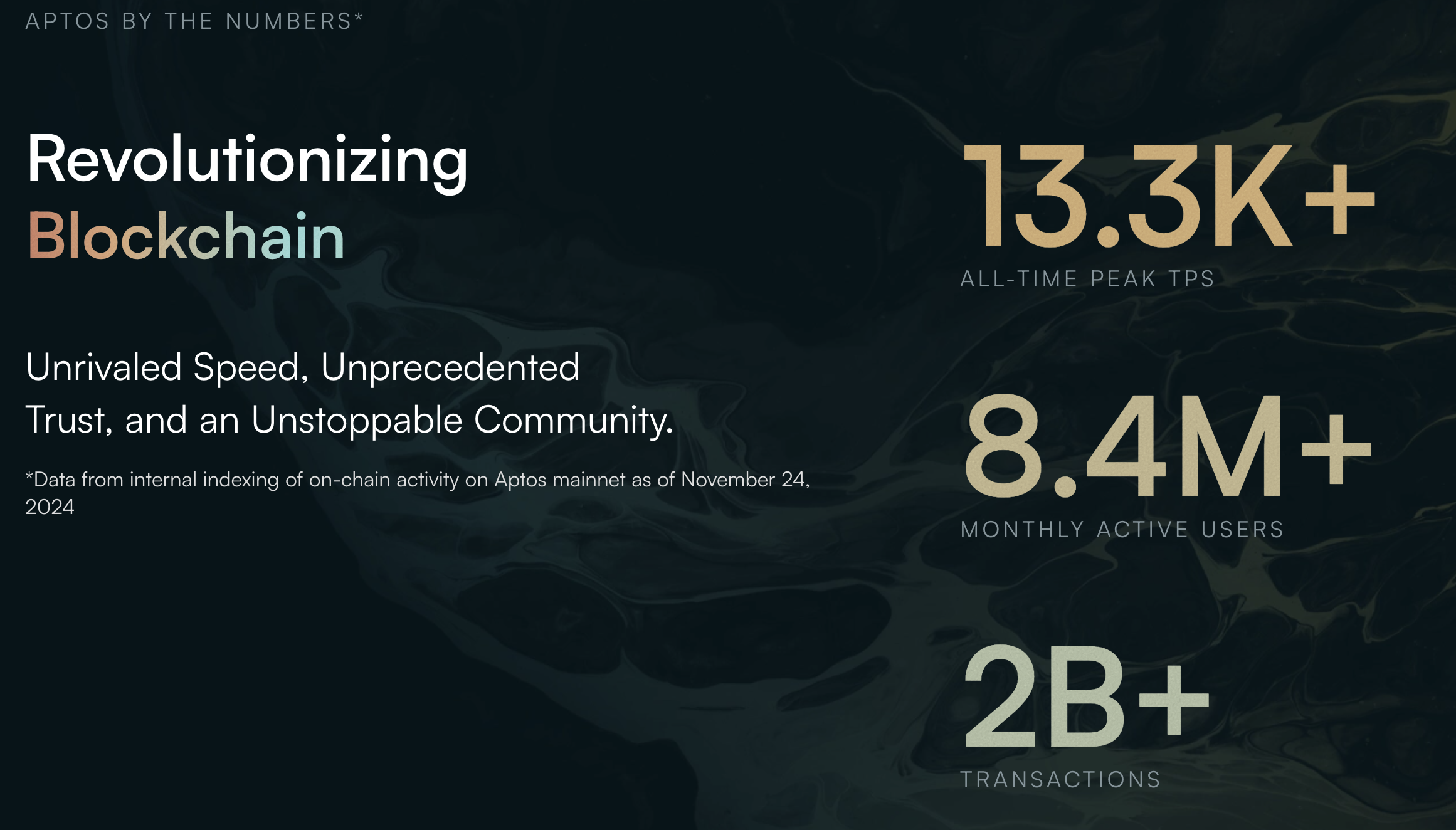
Sui: In controlled testing environments, Sui has demonstrated the capability to process up to 297,000 transactions per second (TPS) under optimal conditions. In early 2025, Sui rolled out “Mysticeti v2", cutting consensus latency further (following a prior ~80% reduction).
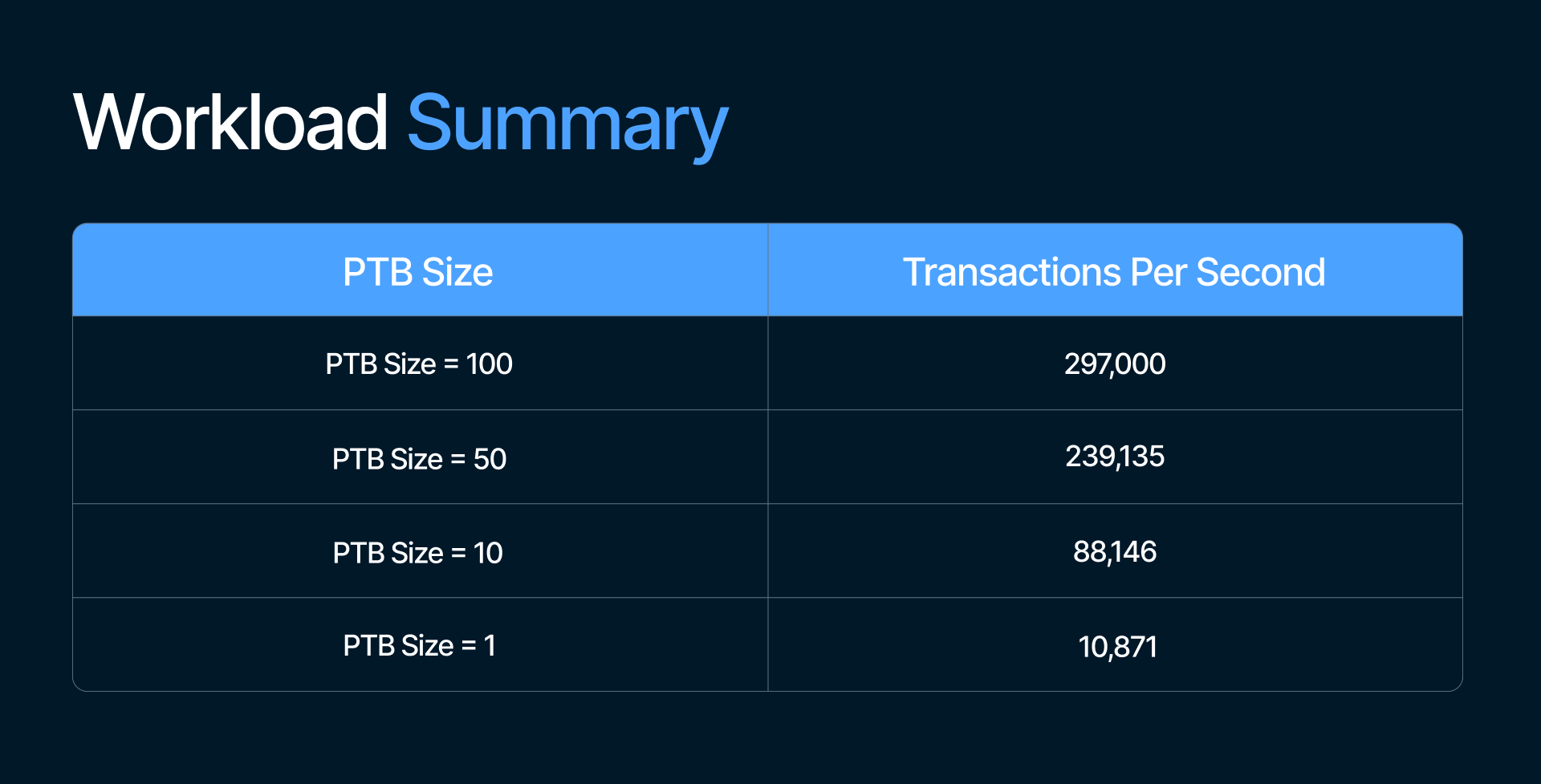
However, real-world performance on the mainnet can differ due to various factors such as network load and user activity. According to data from Suiscan, over the past 12 months, Sui's peak TPS is 822 TPS.
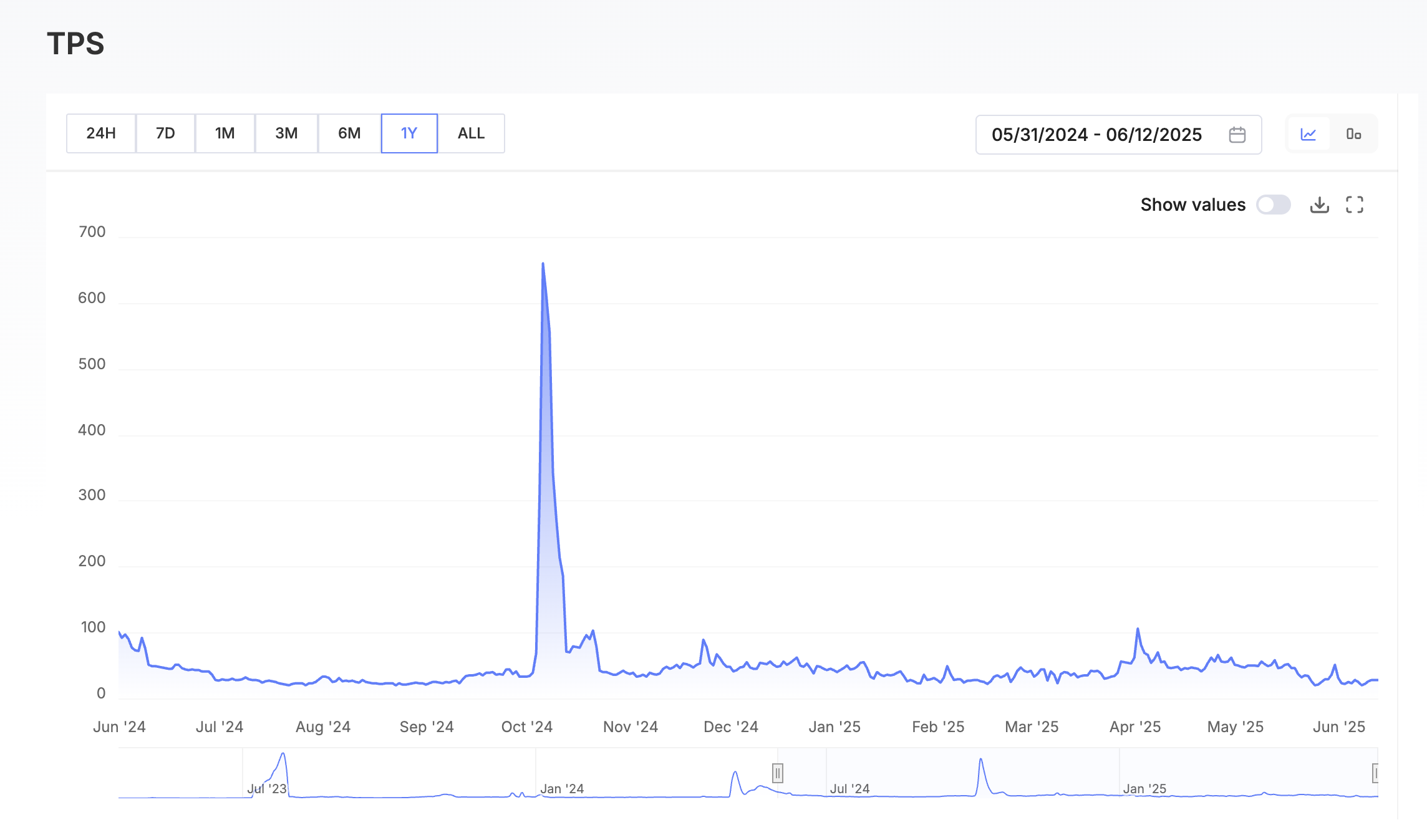
Transaction Fees:
Aptos: According to Aptoscan, over the past year, the average transaction fee on the Aptos blockchain has been approximately 0.0002 APT (~0.002USD).
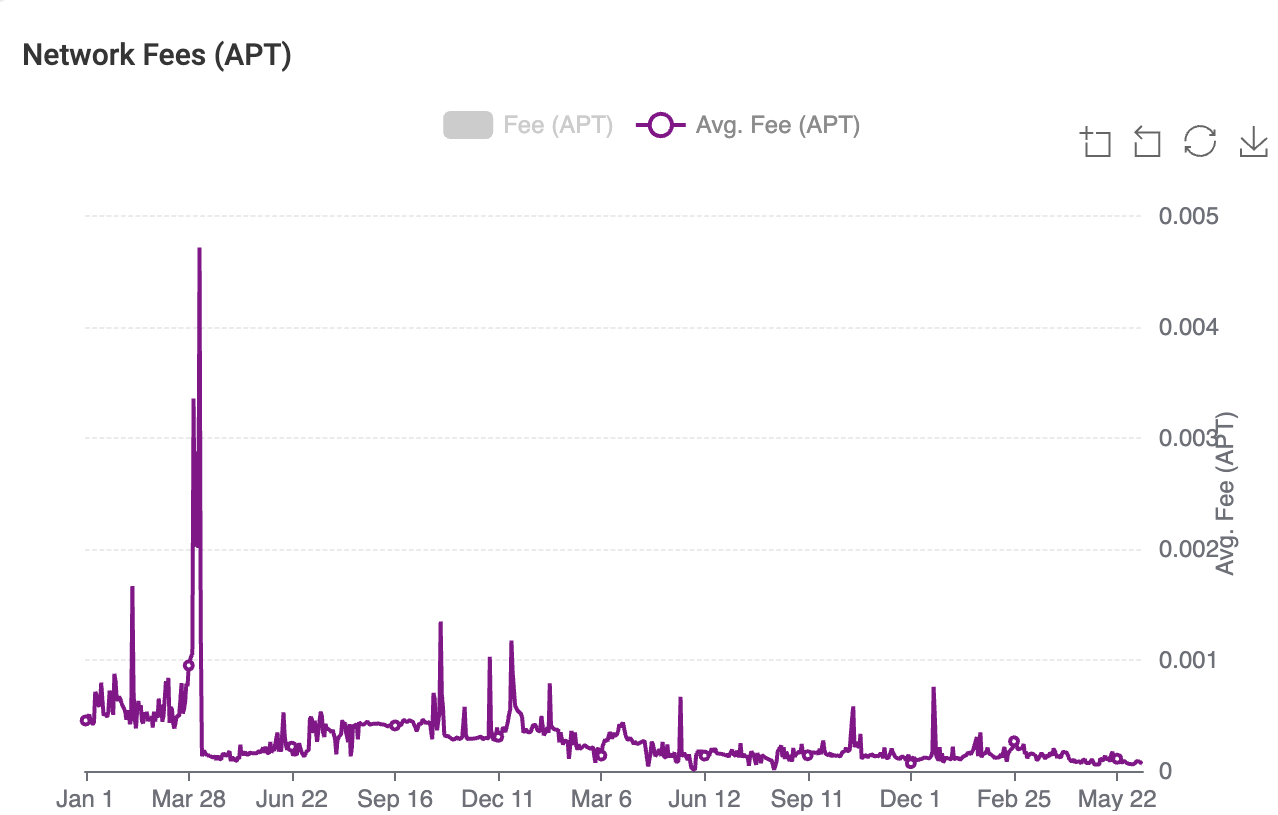
Sui: According to Suiscan, over the past year, the average transaction fee on the Sui blockchain has been approximately 0.0037 Sui (~0.01USD).
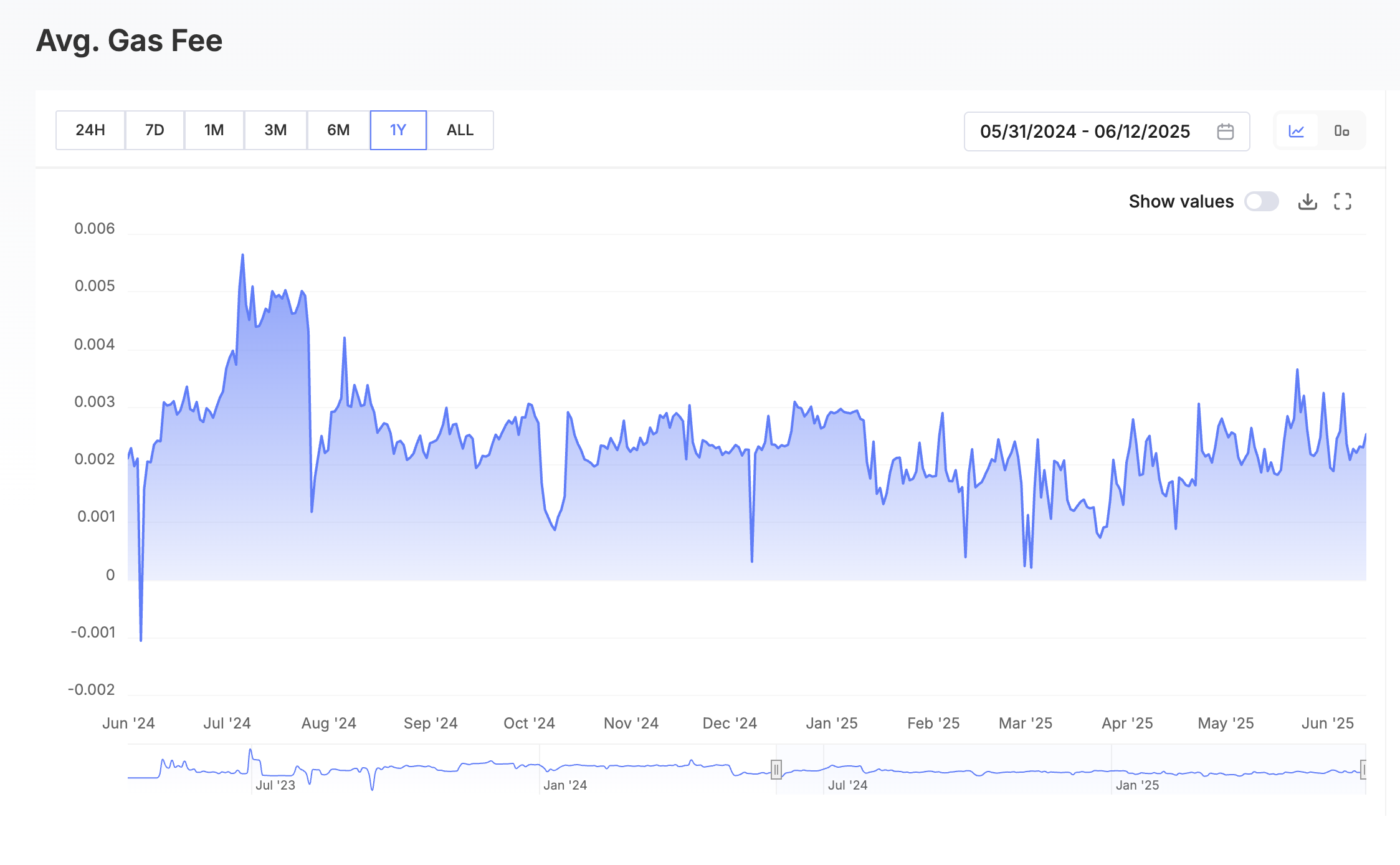
Comparison Summary:
Transaction Speed: While Sui has demonstrated higher potential TPS in testing environments, Aptos has achieved more consistent and higher transaction speeds on its mainnet.
Transaction Fees: Both platforms offer low transaction fees, with Aptos providing a slightly more cost-effective solution.
Aptos vs. Sui: Long-Term Potential
When evaluating the long-term prospects of Aptos and Sui, it's crucial to consider their technological foundations, recent developments, and market positioning.
1. Technological Foundations
Aptos:
Consensus Mechanism: Aptos employs a Byzantine Fault Tolerant (BFT) consensus protocol, ensuring high throughput and low latency. This design supports a wide range of decentralized applications (dApps) with minimal transaction finality times.
Programming Language: Utilizes the original Move programming language, developed for Meta's Diem project, facilitating secure and efficient smart contract development.
Architecture: Features a modular design that allows for seamless upgrades and scalability, accommodating future technological advancements.
Sui:
Consensus Mechanism: Adopts the Narwhal and Tusk consensus protocol, which separates data availability from consensus, enabling efficient transaction processing and high scalability.
Programming Language: Employs a modified version of the Move language with an object-centric model, enhancing flexibility in smart contract development.
Architecture: Utilizes a Directed Acyclic Graph (DAG) structure for data storage, allowing parallel transaction processing and reducing latency.
2. Recent Developments
Aptos:
Ecosystem Expansion: Active development with multiple projects and partnerships enhancing its ecosystem, including collaborations with various decentralized finance (DeFi) platforms and non-fungible token (NFT) marketplaces.
Performance Enhancements: Continuous upgrades to improve transaction throughput and reduce latency, positioning Aptos as a competitive platform for high-performance dApps.
Sui:
Developer Engagement: Growing interest from developers focusing on high-performance applications, particularly in gaming and real-time services, leveraging Sui's rapid transaction finality.
Community Initiatives: Active community engagement through hackathons and developer grants to foster innovation within the Sui ecosystem.
3. Market Position and Adoption
Aptos:
Target Audience: Aims to attract a broad spectrum of dApp developers by offering a scalable and secure platform suitable for various applications, including DeFi, NFTs, and enterprise solutions.
Adoption Strategy: Focuses on building a robust developer community and forming strategic partnerships to drive ecosystem growth and real-world use cases.
Sui:
Target Audience: Concentrates on applications requiring rapid transaction finality, such as gaming and real-time services, leveraging its high throughput capabilities.
Adoption Strategy: Emphasizes performance and scalability to attract developers building high-frequency applications, aiming to establish a niche in the blockchain space.
4. Conclusion:
Both Aptos and Sui present promising long-term potential, each with distinct technological innovations and strategic focuses. Aptos offers a versatile platform suitable for a wide range of applications, while Sui targets high-performance use cases requiring rapid transaction processing. Their success will depend on continued technological advancements, ecosystem development, and the ability to attract and retain a vibrant developer community.
Difference between Aptos and Sui in Supply
Aptos (APT):
Total Supply: 1.128 billion APT tokens.
Circulating Supply: Approximately 534 million APT tokens are currently in circulation, representing about 47.3% of the total supply.
Inflation Rate: Initially, the annual inflation rate was set at 7%. This rate decreases by 1.5% each year until it stabilizes at 3.5%.(expected to take over 50 years).
Staking Yield: According to AptoStake,the recent staking APY of Aptos is about 7.25%
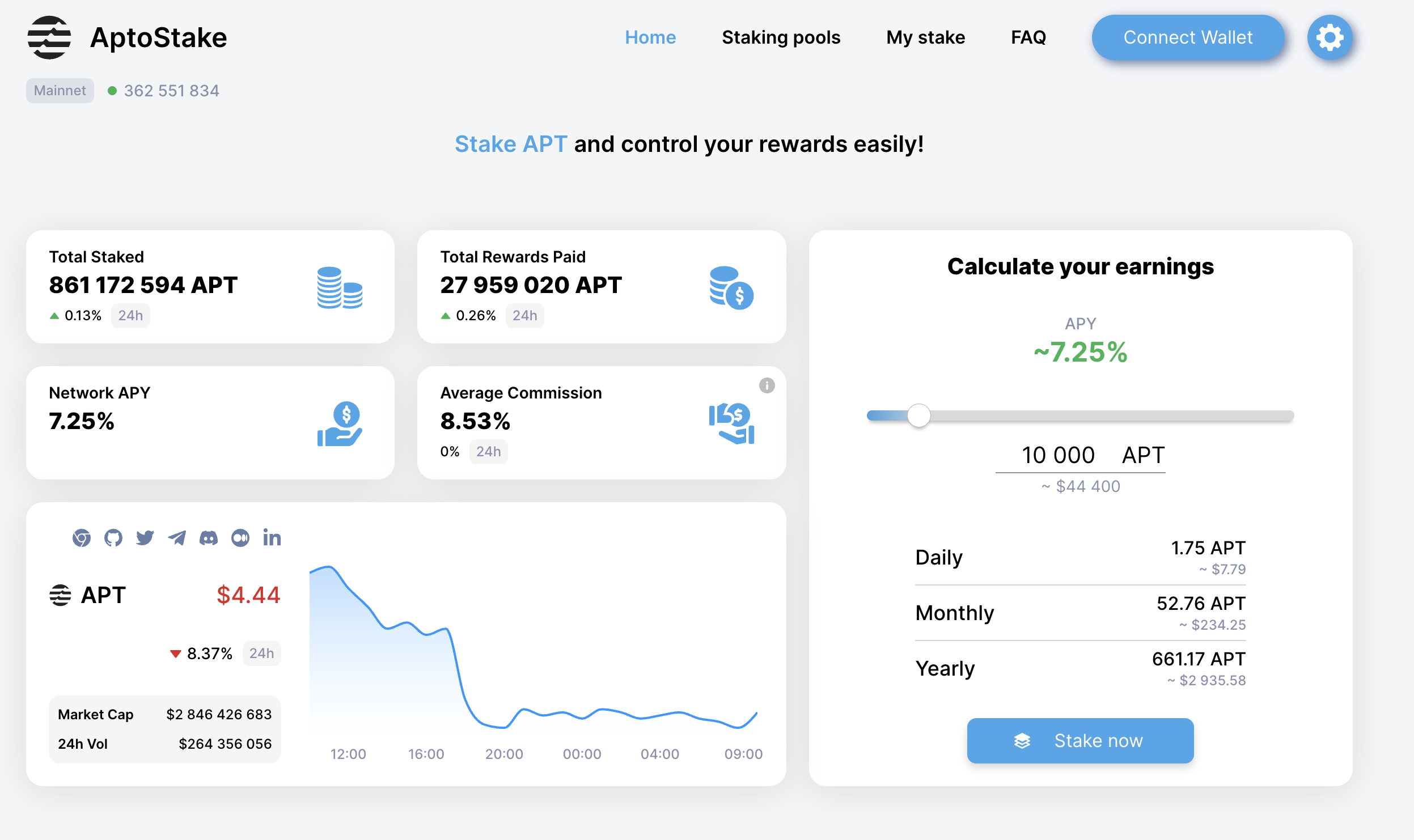
Sui(SUI):
Total Supply: 10 billion SUI tokens.
Circulating Supply: Approximately 2.85 billion SUI tokens are currently in circulation, accounting for about 28.5% of the total supply.
Inflation Rate: Sui has a capped total supply, and there is no indication of an inflationary mechanism.
Staking Yield: According to StakingRewards,the recent staking APY of Sui is about 2.8%
Supply Comparison Table:
Aptos (APT) | Sui (SUI) | |
Total Supply | 1.128 billion APT | 10 billion SUI |
Circulating Supply | ~534 million APT (47.3% of total) | ~2.85 billion SUI (28.5% of total) |
Inflation Rate | The annual inflation rate was set at 7%. This rate decreases by 1.5% each year until it stabilizes at 3.5% | Fixed supply, no inflation |
Staking Yield | 7.25% | 2.80% |
Aptos vs Sui: Consensus Algorithm
Aptos: AptosBFT Consensus Mechanism
1. Byzantine Fault Tolerance (BFT): Aptos employs a variant of the Proof of Stake (PoS) consensus mechanism known as AptosBFT, which is an evolution of the HotStuff protocol. This ensures that the network can reach consensus even if some nodes act maliciously or fail, maintaining security and reliability. 2. Leader Rotation and Reputation System: Aptos introduces an innovative reputation system that automatically adjusts leader rotations based on validator performance. This automation allows Aptos to validate transactions in under a second, enhancing efficiency without human intervention. 3. Parallel Execution with Block-STM: Utilizing Block-STM, Aptos enables parallel execution of transactions by dynamically identifying dependencies and allocating tasks accordingly. This approach allows the network to process up to 160,000 transactions per second (TPS), significantly boosting scalability.
Sui: Narwhal and Tusk Consensus Mechanism
1. Asynchronous Byzantine Fault Tolerance (aBFT): Sui employs an asynchronous BFT consensus protocol comprising two components: Narwhal and Tusk. Narwhal ensures data availability, while Tusk handles transaction ordering. This separation allows for efficient and secure consensus, even in asynchronous network conditions. 2. Causal Ordering for Simple Transactions: For transactions that do not involve shared objects, Sui bypasses traditional consensus by using causal ordering. This method allows for parallel execution of independent transactions, reducing latency and increasing throughput. 3. Parallel Transaction Processing: Sui's architecture is designed to process multiple transactions simultaneously, leveraging its Directed Acyclic Graph (DAG) structure. This design enables Sui to achieve high throughput, with theoretical capabilities of processing up to 297,000 TPS.
Comparison Summary:
Consensus Approach: Aptos utilizes a PoS-based AptosBFT protocol with leader rotation and a reputation system, focusing on rapid finality and validator performance. In contrast, Sui employs an asynchronous BFT protocol (Narwhal and Tusk) and leverages causal ordering for simple transactions, emphasizing parallel processing and scalability.
Transaction Throughput: Aptos achieves up to 160,000 TPS through its Block-STM parallel execution engine. Sui, with its DAG-based architecture, boasts a higher theoretical throughput of up to 297,000 TPS.
Finality and Latency: Both platforms aim for low-latency transaction finality. Aptos achieves sub-second finality, while Sui's design allows for rapid finality, particularly for simple transactions that do not require full consensus.
Aptos vs Sui: Performance over the Past 1 Years
Metric | Aptos(APT) | Sui(SUI) |
1-Year Return | -42.8% | +216.1% |
2025 YTD Return | -49.2% | -21.8% |
Over the past 12 months, Sui has outpaced Aptos in growth—tripling its total value locked (TVL), while Aptos has only doubled, despite launching earlier.
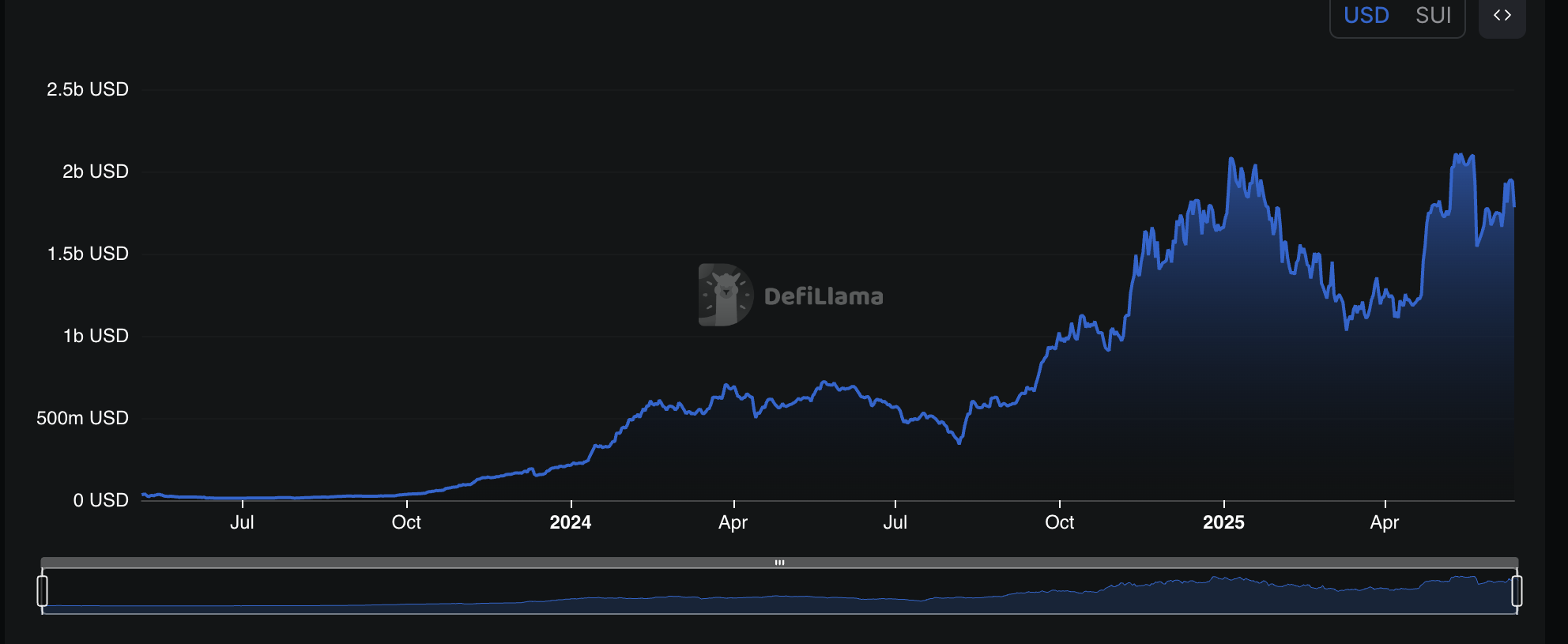
Difference between Aptos and Sui in Security
Aptos:
Consensus Mechanism: Aptos employs a Byzantine Fault Tolerant (BFT) consensus protocol, which enhances security by allowing the network to function correctly even if some nodes act maliciously or fail. This design ensures that the system can tolerate a certain number of faulty nodes without compromising the integrity of the blockchain.
Security Features: The BFT consensus in Aptos provides resilience against various attack vectors, maintaining network stability and data integrity. By requiring a majority agreement among nodes, it prevents malicious actors from easily altering transaction histories or causing disruptions.
Sui:
Consensus Mechanism: Sui introduces an object-centric model, differing from traditional account-based models. This approach allows for parallel transaction processing, which can enhance throughput and efficiency. However, specific details about Sui's consensus algorithm and its security implications are less documented in the available sources.
Security Features: While Sui's object-centric model offers potential performance benefits, the security aspects of this design are not extensively covered in the provided information. Further research into Sui's official documentation would be necessary to fully understand its security model.
Comparison:
Both Aptos and Sui aim to provide secure and efficient blockchain platforms, each with unique approaches to consensus and transaction processing. Aptos leverages a BFT consensus to ensure fault tolerance and security, while Sui's object-centric model focuses on parallel transaction execution. The choice between the two may depend on specific use cases and the importance of certain features such as transaction speed, scalability, and the maturity of the security model.
On May 22, an exploit on the Cetus DEX drained $223 M in assets—but $162 M was swiftly recovered after Sui validators intervened by freezing the attacker’s addresses. While this move raised concerns about decentralization, it also demonstrated the network’s ability to respond decisively to unethical activity and protect users in critical moments. Sui’s validator coordination may not reflect a fully permissionless structure yet, but it shows a clear commitment to security and user protection during high-stakes incidents
Aptos vs. Sui: Earning Opportunities
Aptos (APT):
Staking: Aptos operates on a Delegated Proof-of-Stake (DPoS) consensus mechanism, allowing APT holders to delegate their tokens to validators. By doing so, participants contribute to network security and earn staking rewards. The current annual percentage yield (APY) for staking APT is approximately 7.25%.
Delegated Staking: Aptos introduced delegated staking to enhance accessibility. This feature enables users to delegate their staking power to trusted validators without running a validator node themselves, thereby earning rewards while maintaining control over their tokens.
Transaction Fees: Transaction fees on the Aptos network are currently burned, meaning they are removed from circulation. This approach may be revisited in the future through on-chain governance voting.
Sui (SUI):
Staking: Sui utilizes a Delegated Proof-of-Stake (DPoS) system, allowing SUI token holders to delegate their tokens to validators. In return, they earn staking rewards. The current APY for staking SUI is approximately 2.8%.
Validator Selection: When staking on Sui, choosing a reliable validator is crucial, as factors like commission rates and validator performance can impact the rewards received. Stakers should periodically review their chosen validator's performance to optimize earnings.
Transaction Fees: Transaction fees collected on the Sui network are distributed to delegators in proportion to their stake. This means that active participation in staking not only secures the network but also provides a share of the transaction fees as rewards.
Comparison:
Staking Rewards: Aptos offers a higher staking APY (∼7.25%) compared to Sui's ∼2.8%.
Delegated Staking: Both networks support delegated staking, enabling token holders to earn rewards without operating validator nodes.
Transaction Fees: On Aptos, transaction fees are currently burned, whereas on Sui, they are distributed to stakers, providing an additional earning avenue.
In summary, both Aptos and Sui provide earning opportunities through staking, with Aptos offering a higher APY. However, Sui's model includes the distribution of transaction fees to stakers, potentially enhancing overall rewards.
Aptos vs. Sui: Adoption and Community Support
Adoption Overview
Aptos: Aptos is a Layer 1 blockchain platform that emphasizes scalability, safety, and user experience. Since its mainnet launch in 2022, Aptos has seen significant growth, with numerous projects and decentralized applications (dApps) being developed within its ecosystem. The platform's focus on developer-friendly tools and resources has attracted a vibrant community of builders and users. In 2025, Aptos was also powering the official digital wallet for Expo 2025 in Osaka, processing 558,000+ transactions and onboarding 133,000+ users.
Sui: Sui is another Layer 1 blockchain that aims to deliver high-performance and secure decentralized applications. The Sui Foundation is dedicated to advancing the global adoption of the Sui blockchain, with initiatives to onboard the next billion users to web3. Sui's unique object-centric model and Move programming language have garnered interest from developers seeking innovative solutions. Riding the momentum of cryptocurrency spot ETFs, Sui has also submitted an application to the SEC this year—signaling growing interest from institutional investors.
Community Support
Aptos: The Aptos community is active and growing, with various programs to engage and support its members. The Aptos Collective, the official ambassador program, brings together passionate contributors to collaborate on ecosystem projects and participate in exclusive initiatives. Additionally, the Aptos Foundation provides grants and resources to developers and projects that contribute to the network's growth.
Sui: The Sui community is also robust, with the Sui Foundation playing a pivotal role in fostering engagement. The foundation offers grants to developers, educators, researchers, and community members driving the adoption and advancement of Sui. Community events and programs provide opportunities for networking and collaboration among Sui builders.
Real-World Usage
Aptos: Aptos supports a wide range of applications, including decentralized finance (DeFi), non-fungible tokens (NFTs), and gaming. Its high throughput and low latency make it suitable for applications requiring fast and efficient transaction processing. The platform's developer-friendly environment has led to the creation of various tools and services that enhance user experience.
Sui: Sui's architecture is designed to support high-performance dApps, with a focus on delivering the benefits of web3 with the ease of web2. The platform's unique data model and consensus mechanism enable efficient transaction processing, making it suitable for applications that demand high scalability and security.
Conclusion
Both Aptos and Sui are making significant strides in the blockchain space, each with unique approaches to adoption and community engagement. Aptos's emphasis on scalability and developer support has cultivated a dynamic ecosystem of dApps and services. Meanwhile, Sui's focus on delivering web3 benefits with web2 ease positions it as a compelling platform for high-performance applications. The choice between the two depends on specific use cases and the desired features for developers and users.
Aptos vs. Sui: Which One Is Better?
Aptos and Sui are emerging Layer 1 blockchain platforms, each offering unique features and targeting different aspects of the blockchain ecosystem.
Aptos:
Scalability and Performance: Aptos utilizes a Byzantine Fault Tolerant (BFT) consensus mechanism, enabling high throughput and low latency. This design supports a wide range of applications, including decentralized finance (DeFi), non-fungible tokens (NFTs), and gaming.
Developer-Friendly Environment: Aptos emphasizes a developer-centric approach, providing robust tools and resources to facilitate the creation of decentralized applications (dApps). This focus has attracted a growing community of developers and projects to its ecosystem.
Sui:
Innovative Data Model: Sui introduces an object-centric data model, allowing for parallel transaction processing. This architecture enhances scalability and performance, making it suitable for applications requiring high throughput.
Focus on Web3 Adoption: Sui aims to deliver the benefits of Web3 with the ease of Web2, striving to onboard the next billion users to decentralized applications. The Sui Foundation supports developers and projects through grants and resources, fostering a vibrant ecosystem.
Conclusion:
Both Aptos and Sui offer compelling features tailored to different use cases. Aptos's emphasis on scalability and a developer-friendly environment makes it an attractive choice for building diverse dApps. In contrast, Sui's innovative data model and focus on seamless Web3 adoption position it as a strong contender for applications requiring high performance and user-friendly experiences. The choice between Aptos and Sui depends on specific project requirements and goals. Developers and businesses should consider factors such as scalability needs, development tools, community support, and the target user base when selecting a platform.
 00:00
00:00